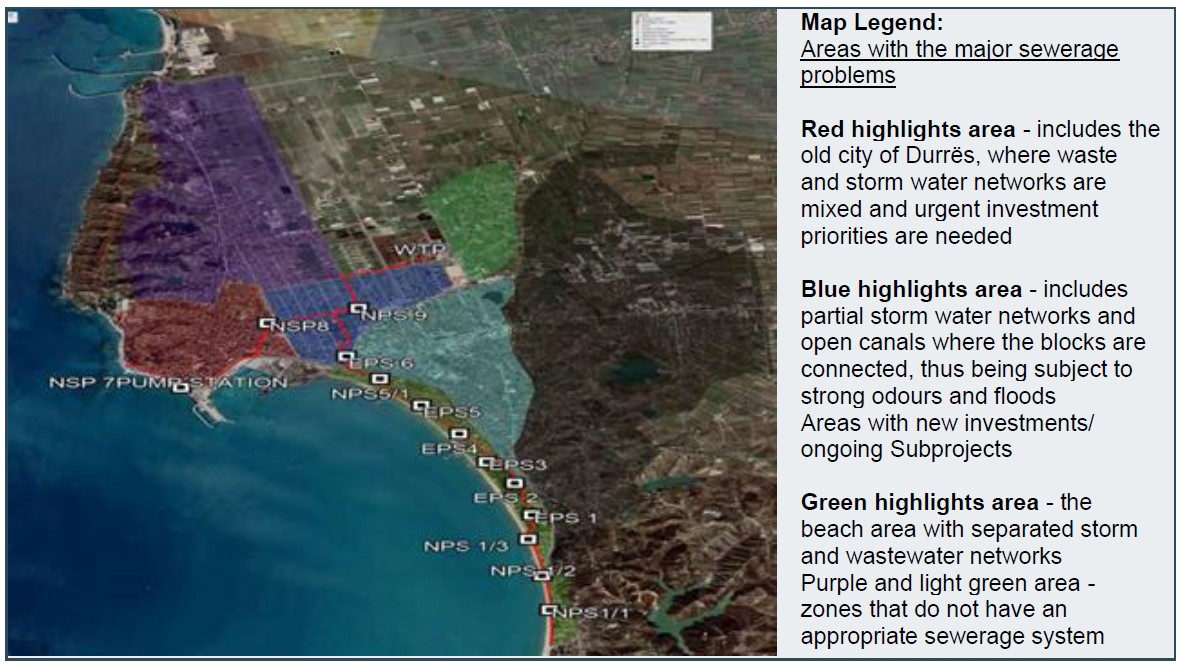The subproject (WB25-ALB-ENV-01) concerns infrastructure investments in the Durres region, the main harbour and the city of Albania along the Ionian coast. Durres is the main seaport and city on the Adriatic coast in Albania. The metropolitan area of Durres (Durres city: 175,000 inhabitants), including 5 municipalities and 10 communes has a total population of about 350,000 people during the off-peak seasons.
The city’s infrastructure has benefited from investments in recent year despite the lack of a master plan. Nevertheless, the wastewater collection system is obsolete, made of concrete pipelines prone to infiltration and flow disruption, lack of proper sloping and often becoming subject to blockages. The majority of the sewerage collection systems are combined and collect wastewater together with rainwater.
Only the south part of the city has a separate storm water and sewage network. According DWSU, 20% of Durres households are not connected to sewerage networks and use septic tanks. Around 3,000 customers are directly connected to the open drainage channel. As a result, they are subject to heavy odours, and, in case of heavy rains (often occurring), the mixed urban and rain wastewater floods the city streets. In addition, substantial volumes of wastewater are outflowing to the sea due to poor connection rate, wastewater infiltration, and overflowing during dry weather and rainy events.
The construction of Durres WWTP in 2013 and improvements delivered in 2019 resulted in the collection and treatment of about half the wastewater generated within the city. The amounts of wastewater collected in the old city centre and directed to the WWTP are unknown due to the condition of the current networks and the lack of measurements. The other half, substantial volumes of wastewater, are being discharged untreated in the Adriatic, mainly through the open drainage channel crossing the city and flowing towards Porto Romano in the north. In order to bring Durres Wastewater Treatment Plant (WWTP) up to its design capacity of 60,000 m3/day (or 250,000 PE), while maximising the biological load of the wastewater directed to the WWTP, the Durres wastewater collection networks need to be developed and restructured.
While DWSU is responsible for sewerage management in its service area where collection and treatment infrastructures exist (Durres city and Gjiri Lalzit area), storm water collection is usually under the management of the respective municipalities. However, because of the mixed networks and effluents as well as unclear boundaries regarding infrastructures, responsibilities and lack of resources from Durres municipality, DWSU is often called to intervene to clean storm water networks.
The collection and treatment of wastewater will reduce the development of insects and water-borne diseases. It will also improve the quality of surface and underground water bodies in the region and coastal water in the Adriatic Sea, providing a favourable impact to biodiversity and tourism. An integrated and/or well-coordinated sanitation management of both waste- and storm water between DWSU and the Durres municipality is key to pave the way towards effective performance achievements on this subject. A similar approach is recommended in municipalities located around Durres (Sukth and Shijak, among others), where waste- and storm waters are directed to rivers.
The WBIF under IPF 11 supports the preparation of the feasibility study, preliminary design, and environmental and social assessment to rehabilitate and develop a separate storm water and wastewater network for the city through the grant WB25-ALB-ENV-01.
